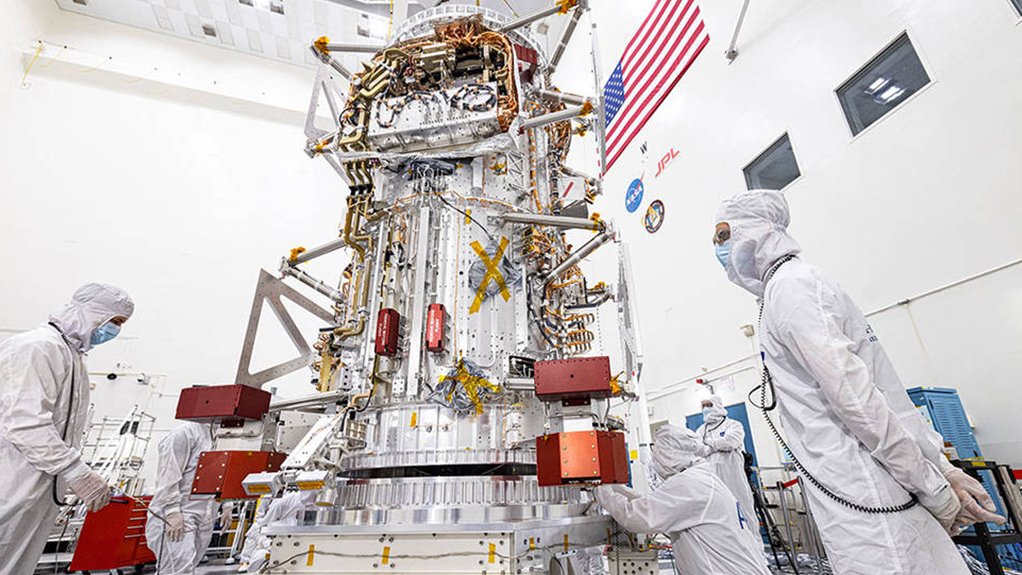Nasa takes delivery of the main body of its biggest yet planetary probe
The US National Aeronautics and Space Administration (Nasa) has reported that the main body of its largest-ever planetary space probe, the Europa Clipper, had been delivered to its Jet Propulsion Laboratory (JPL) in southern California. The main body was assembled by the Johns Hopkins Applied Physics Laboratory in the US state of Maryland and flown to JPL, on the other side of the country.
“It’s an exciting time for the whole project team and a huge milestone,” enthused Nasa JPL Europa Clipper project manager Jordan Evans. “This delivery brings us one step closer to launch and the Europa Clipper science investigation.”
The main body is made from aluminium and is 3 m tall and 1.5 m wide, and includes already integrated systems and equipment such as cabling, electronics, radios, thermal loop tubing as well as its propulsion system. Over the next two years, engineers and technicians at JPL will complete the spacecraft by installing, by hand, its flight hardware, instruments, power converters, scientific experiments, wiring, communications antennas and solar panel arrays. They will then test it to ensure that it can successfully execute its mission.
That mission is to fly sail out to Jupiter, the largest planet in the Solar System, and one surrounded by its own mini-system of Moons, including four that are pretty much like planets. One of those four is Europa, and Europa is special because it is covered by a shell of ice, under which, scientists are confident, lies a salt-water ocean (or perhaps slush), in which life might have evolved. Data from previous spacecraft and Earth-based telescopes suggest that the ice shell could be 15 km to 25 km thick, and the ocean beneath it could have depths from 60 km to 150 km.
After it reaches, and goes into orbit around, Jupiter, Europa Clipper will carry out almost 50 flybys of Europa. Its instruments will collect data on the icy world’s atmosphere, its surface and its interior. This data will be used to determine the thickness of the ice shell and the depth and salinity of the ocean underneath it. It will also allow scientists to determine if there are any plumes of water blowing upwards from under the ice surface, into space.
The spacecraft is so designed that its electronics will be protected from the fierce radiation emitted by Jupiter. Its engine will be used for both major manoeuvres, including the deceleration needed to insert Europa Clipper into Jovian orbit, and small, including fine-tuning, manoeuvres to optimise its attitude as it flies by Europa (and other worlds). Launch is scheduled for October 2024 and the spacecraft should reach Jupiter, after a 2.9-billion-kilometre voyage, in 2031.
Comments
Press Office
Announcements
What's On
Subscribe to improve your user experience...
Option 1 (equivalent of R125 a month):
Receive a weekly copy of Creamer Media's Engineering News & Mining Weekly magazine
(print copy for those in South Africa and e-magazine for those outside of South Africa)
Receive daily email newsletters
Access to full search results
Access archive of magazine back copies
Access to Projects in Progress
Access to ONE Research Report of your choice in PDF format
Option 2 (equivalent of R375 a month):
All benefits from Option 1
PLUS
Access to Creamer Media's Research Channel Africa for ALL Research Reports, in PDF format, on various industrial and mining sectors
including Electricity; Water; Energy Transition; Hydrogen; Roads, Rail and Ports; Coal; Gold; Platinum; Battery Metals; etc.
Already a subscriber?
Forgotten your password?
Receive weekly copy of Creamer Media's Engineering News & Mining Weekly magazine (print copy for those in South Africa and e-magazine for those outside of South Africa)
➕
Recieve daily email newsletters
➕
Access to full search results
➕
Access archive of magazine back copies
➕
Access to Projects in Progress
➕
Access to ONE Research Report of your choice in PDF format
RESEARCH CHANNEL AFRICA
R4500 (equivalent of R375 a month)
SUBSCRIBEAll benefits from Option 1
➕
Access to Creamer Media's Research Channel Africa for ALL Research Reports on various industrial and mining sectors, in PDF format, including on:
Electricity
➕
Water
➕
Energy Transition
➕
Hydrogen
➕
Roads, Rail and Ports
➕
Coal
➕
Gold
➕
Platinum
➕
Battery Metals
➕
etc.
Receive all benefits from Option 1 or Option 2 delivered to numerous people at your company
➕
Multiple User names and Passwords for simultaneous log-ins
➕
Intranet integration access to all in your organisation




















